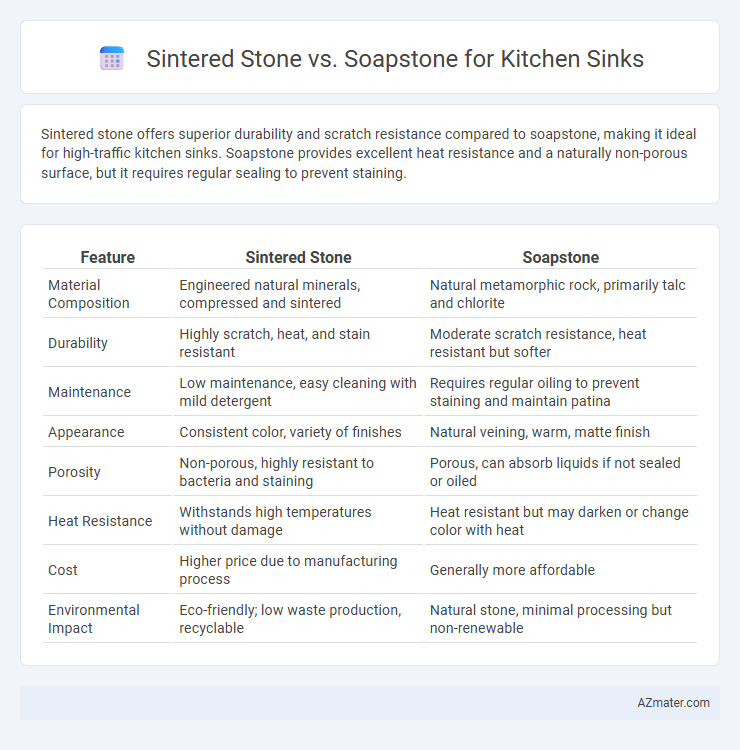Sintered stone offers superior durability and scratch resistance compared to soapstone, making it ideal for high-traffic kitchen sinks. Soapstone provides excellent heat resistance and a naturally non-porous surface, but it requires regular sealing to prevent staining.
Table of Comparison
| Feature | Sintered Stone | Soapstone |
|---|---|---|
| Material Composition | Engineered natural minerals, compressed and sintered | Natural metamorphic rock, primarily talc and chlorite |
| Durability | Highly scratch, heat, and stain resistant | Moderate scratch resistance, heat resistant but softer |
| Maintenance | Low maintenance, easy cleaning with mild detergent | Requires regular oiling to prevent staining and maintain patina |
| Appearance | Consistent color, variety of finishes | Natural veining, warm, matte finish |
| Porosity | Non-porous, highly resistant to bacteria and staining | Porous, can absorb liquids if not sealed or oiled |
| Heat Resistance | Withstands high temperatures without damage | Heat resistant but may darken or change color with heat |
| Cost | Higher price due to manufacturing process | Generally more affordable |
| Environmental Impact | Eco-friendly; low waste production, recyclable | Natural stone, minimal processing but non-renewable |
Introduction: Sintered Stone vs Soapstone for Kitchen Sinks
Sintered stone offers superior durability, resistance to scratches, stains, and heat, making it an ideal choice for kitchen sinks compared to soapstone. Soapstone, a natural material, provides a softer, warmer aesthetic but is more prone to dings and requires regular maintenance to prevent staining. Choosing between sintered stone and soapstone hinges on balancing long-term durability with the desired kitchen sink appearance.
Material Composition and Properties
Sintered stone, composed of natural minerals fused under extreme heat and pressure, offers exceptional hardness, scratch resistance, and non-porous properties, making it highly durable for kitchen sinks. Soapstone, a metamorphic rock primarily made of talc and chlorite, is softer and more porous but renowned for its heat resistance and chemical inertness, providing a naturally anti-bacterial surface. The dense, engineered nature of sintered stone results in superior stain and impact resistance compared to the more easily scratched and patina-developing soapstone.
Durability and Longevity Comparison
Sintered stone sinks offer exceptional durability due to their high resistance to scratches, heat, and staining, making them ideal for heavy kitchen use. Soapstone sinks, while naturally resistant to heat and chemicals, are softer and more prone to surface scratches that may develop a unique patina over time. Both materials provide long-lasting performance, but sintered stone generally ensures greater structural integrity and requires less maintenance for sustained longevity.
Aesthetic Options and Design Flexibility
Sintered stone offers a broader range of aesthetic options with its ability to mimic natural materials like marble, granite, and concrete, providing a sleek, modern appearance ideal for contemporary kitchen designs. Soapstone features a warm, matte finish with subtle veining that enhances rustic or traditional kitchen styles but has limited color variations compared to sintered stone. Design flexibility is higher with sintered stone due to its availability in large, thin slabs that can be shaped and customized easily, while soapstone's density and hardness restrict its design adaptability and edge detailing.
Stain and Heat Resistance
Sintered stone exhibits superior stain resistance compared to soapstone, making it a low-maintenance option for kitchen sinks prone to spills and acidic substances. Soapstone, however, offers excellent heat resistance, tolerating high temperatures without damage, which is ideal for direct contact with hot pots and pans. Both materials provide durability, but selecting sintered stone prioritizes stain protection while soapstone excels in thermal resilience.
Maintenance and Cleaning Requirements
Sintered stone kitchen sinks offer high resistance to stains, scratches, and heat, making maintenance simple with just mild soap and water for daily cleaning. Soapstone sinks require periodic oiling to maintain their dark patina and prevent surface dryness but are naturally resistant to bacteria and stains. Both materials resist common kitchen chemicals, yet sintered stone demands less upkeep, providing a more durable, low-maintenance option.
Environmental Impact and Sustainability
Sintered stone sinks offer superior sustainability due to their manufacturing process, which uses natural minerals and requires less water and energy compared to soapstone quarrying. Soapstone is a natural material with a long lifespan and is non-porous, but its extraction can cause environmental disruption through quarrying activities. Both materials are durable and recyclable, but sintered stone's eco-friendly production methods provide a notable advantage in reducing carbon footprint and resource consumption in kitchen sink applications.
Cost Analysis: Sintered Stone vs Soapstone
Sintered stone kitchen sinks generally cost between $600 and $1,200, offering superior durability and resistance to heat, scratches, and stains compared to soapstone. Soapstone sinks range from $500 to $1,000, favored for their natural antimicrobial properties and softer texture but require regular oiling and maintenance. The initial investment in sintered stone is higher, but its longevity and low maintenance can offset costs over time, while soapstone's lower upfront price may lead to increased upkeep expenses.
Installation Considerations
Sintered stone kitchen sinks require professional installation due to their heavy weight and rigidity, often needing custom cabinetry adjustments and reinforced support structures. Soapstone sinks are easier to install because of their slightly softer composition and lower weight, allowing for simpler cutouts and standard mounting hardware compatibility. Both materials demand precise sealing to prevent water damage, but sintered stone's low porosity reduces maintenance compared to the natural porosity of soapstone.
Which Is Best for Your Kitchen Sink?
Sintered stone offers superior durability and resistance to heat, scratches, and stains, making it an excellent choice for busy kitchens, while soapstone provides a softer, natural feel with excellent heat resistance but is more prone to scratches and requires regular maintenance. The non-porous, hygienic nature of sintered stone ensures easier cleaning and longevity, whereas soapstone develops a charming patina over time but may need periodic sealing to prevent staining. For homeowners seeking a low-maintenance, highly durable kitchen sink, sintered stone is typically the best option, whereas soapstone appeals to those favoring a warm, traditional aesthetic despite added upkeep.

Infographic: Sintered stone vs Soapstone for Kitchen Sink
 azmater.com
azmater.com